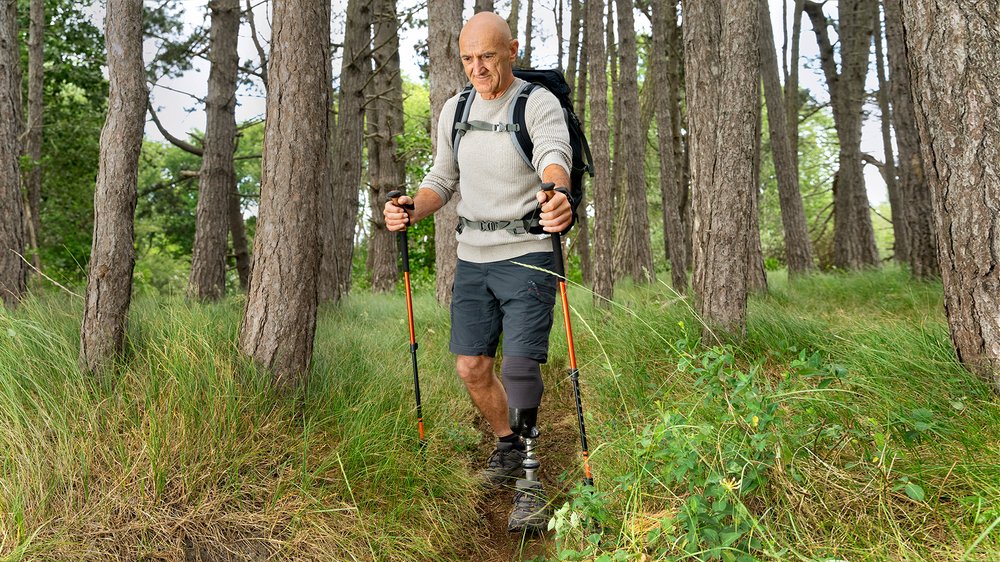Activity after an amputation: Nordic walking!
Nordic walking is the perfect way to stay active, even after undergoing an amputation. Nordic walking has become increasingly popular in recent years. One of the reasons for this is that it does not require a high level of effort.
Nordic walking offers numerous health advantages, such as a lower risk of cardiovascular disease, lower blood pressure and improved heart and vessel function. It improves your coordination, strengthens your muscles and bones and keeps your joints healthy. You can do this activity at your own pace outdoors while getting a breath of fresh air and enjoying the sun or rain. Whether you do it alone, with friends or as a group, Nordic walking keeps you fit, happy and healthy.
Can I do Nordic walking with a leg amputation? Is that even possible?
Absolutely! Nordic walking is suitable for all types of amputations. It is a comfortable and easy way to get or stay active. You can start slowly and gradually increase your pace the fitter you become.
Nordic walking is a great way to continuously improve your activity or performance level. The poles offer safety and stability at the start and with a bit of practice, it will become more and more of a sport.
What kind of prosthesis do I need for Nordic walking?
You do not need a specific prosthesis – your daily prosthetic equipment is sufficient and does not require any specific settings or modifications. You only need to make sure that your prosthesis fits well and that you are able to walk on it. In other words, that you are able to move without any walking aids such as crutches.
What else do I need to get started with Nordic walking?
The most important thing is that you enjoy being active outdoors and are motivated.
You also need quality footwear and appropriate clothing, depending on the weather. Nordic walking poles are available at outdoor and sports shops, where they can adjust them to your height. If you buy them online, you determine the right pole length by multiplying your height (cm) by 0.68 and then rounding down to the nearest pole size. To check the size, hold the Nordic walking pole in front of you while standing in an upright position. Your forearm should be horizontal and your elbow at a 90-degree angle.

How do I get started with Nordic walking?
You can start right away, so why wait! Feeling motivated? Give it a try. Start by walking a short route close to home. Flat terrain without any challenges like hills is preferable. If possible, find someone to show you the right walking technique with the poles, such as a Nordic walking coach, or join a Nordic walking club. Sports clubs and gyms also often offer group activities like this. For example, have a look at https://nordicwalking.nl/ .
What do I need to consider? How can I make sure I’m doing it right?
First of all, you can’t do it wrong! You are able to walk and that’s half the battle. Simply add the poles and you’re on your way. There are, however, a few tips that can be followed to ensure greater enjoyment.
-
Important: check your residual limb often. If there is a pressure point or your skin is chafing, stop immediately and have your O&P professional check your socket.
-
Make sure to slide the straps of your walking poles over your wrists and grip the pole lightly. You do not need to hold on tightly.
-
Do not walk too quickly and listen to your body. You should be able to talk with your walking mates.
-
Watch your step length. At first, it may feel a bit awkward using your Nordic walking poles, so do not take very large steps. Your steps should be a slightly wider than with normal daily walking.
-
Keep the poles close to your body and your opposite arm should move with your opposite leg. In other words, lift your left leg and right arm forward at the same time and vice versa – kind of like when walking.
-
Position your walking poles next to your body. To master the right technique, you can start by simply dragging the poles behind you as you walk. Next, grab to your poles and plant them at the same angle (45-60°) as you dragged them. Finally, push your body forward by applying pressure to each pole.
How do I improve my performance after practising for a while?
You can increase your walking speed, distance or frequency. You can also try a different terrain, such as different types of ground at different heights. Once you’ve mastered it, how about trying Nordic running?